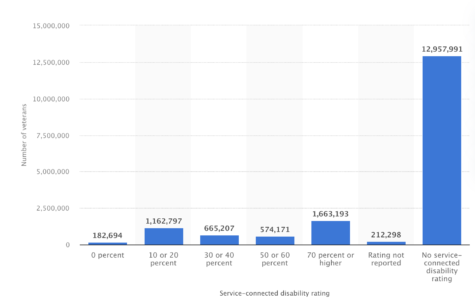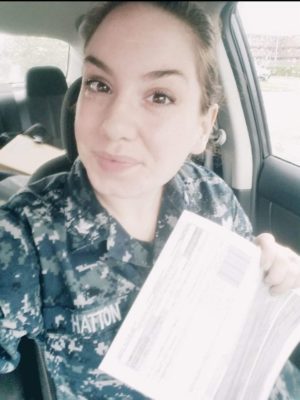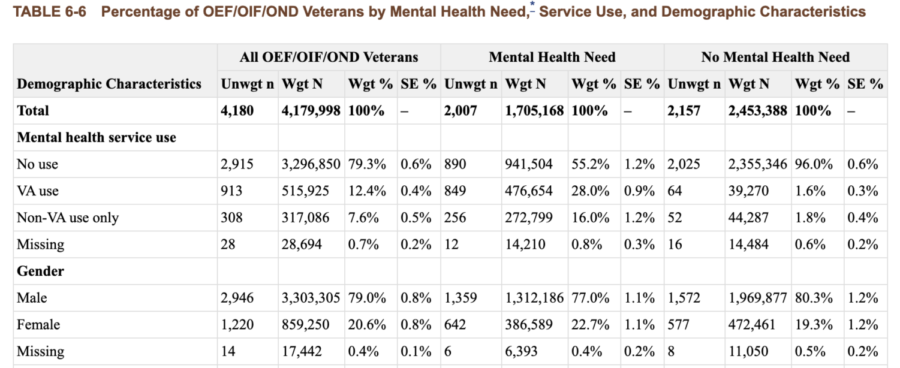Tales from our troops: being a disabled veteran
Content Warning: Obscene language in this article may be offensive to some readers.

According to Statista, a database of statistics for market data, as of 2019 roughly 1.66 million veterans had service-related disability ratings of 70% or higher.

U.S. Army Veteran Matthew Kirkland, U.S. Navy Veteran Sierra Hatton, and U.S. Air Force Veteran Taylor Sisk are disabled veterans.
“I broke my ankle twice, I have two medical issues with both my knees, I have a curve in my back due to all of the heavy weight we carried, I have pinched nerves in both my arms, I got asthma from getting bronchitis really bad when I was at Fort Drum, New York, where it is cold all the time, I have anxiety, depression, trouble sleeping, and I do not feel comfortable in large crowds or around people I do not know,” said Kirkland.
Sisk is a disabled veteran because he received surgery on his shoulder from a service-related injury and has tinnitus in his ears.
“I have a few, like knee pain, back pain, and anxiety. I have friends that have claims for anxiety, depression or PTSD,” said Hatton.
According to the Department of Veterans Affairs (VA), prior to starting an application for disability benefits, a service must find out if they are eligible for VA disability compensation. Once they have determined their eligibility, the veteran must gather evidence to submit while they file their claim.
“You apply and the VA goes over your medical records to see if the things are service related, and they send you out to a doctor to be evaluated. Then the VA makes the decision on your individual ratings and there’s a formula they follow to decide your overall rating,” said Hatton.

The type of evidence the VA encourages veterans to provide to support their claim includes any VA medical records and hospital records related to the illness or injury, or proof that the preexisting disability has worsened to increase a rating, and statements from others who can speak on your behalf such as family members, friends, law enforcement, or previous service members the veteran has worked with who can speak on their behalf about the illness or injury. This process is often time consuming.
“The initial process to get some help was terrible, sending me to physical therapy for years instead of doing what I suggested, that is until I was on my last Physical Training (PT) failure, and they finally did what I asked. After that, it was easy. Getting the compensation was also easy in my situation. I filled out a few forms, went to a few appointments and received my rating within a couple months,” said Sisk.
“I had to fight them for every single thing. Some things I claimed they denied because they said there is no paperwork of it, which is a load of shit because the military doesn’t actively attempt to keep you from sick call, but they will treat you terribly if you go. I remember getting bruised ribs from combative training, I went to sick call a day later because they were closed, and I still had to do combatives with injured ribs, which still hurt to this day,” said Kirkland.
When a service member finally receives their rating and they begin receiving their disability benefits, other problems may arise over time.

“I’ve had problems that have gotten worse since my initial rating. You can apply for additional compensation. I did and was given it for some things. But other things they can decide not to increase the rating. like my right knee hurts me because it’s compensating for my left knee which I’ve had pain in since almost the beginning of my time in the Navy,” said Hatton. “I fell really bad, heard a snap and then going up and down ladder wells especially on a roving watch for years. Both knees are painful, and they click and crack. The doctor examining me even felt and heard the pop when she bent my knee. I even complained about my right knee when I was still in.”
Disability ratings are not set in stone, and the VA can adjust based on how they see fit depending on the circumstance.
“However, the VA decided not to increase or give a rating because it wasn’t service connected. They can increase your rating or leave it alone. The scary part is if you decide to apply for an increase, they could decide not only do you not need an increase, but they could decrease your rating or take it away too,” Hatton said.
Once disability status is established, veterans occasionally have access to care and assistance for treating the disability.

“The VA has helped quite a bit, providing medication to help stabilize my depression after my wife left me, basically for free. I haven’t went back for my shoulder, but they did tell me my other shoulder is not service connected despite it being in my medical records,” said Sisk.
Even though access to care may be provided by the VA for disabled veterans, not many veterans decide to use additional services. For example, according to the Evaluation of the Department of Veterans Affairs Mental Health Services, while approximately 140,000 new veterans become eligible yearly to receive mental health services through the VA, only slightly more than half of those veterans use VA’s health care services.

“I can get medical care through them but it’s a very long complicated process, and with already not liking going to the doctor, I usually just suffer through. One time I tried to go to therapy because my mental state just got unmanageable. It took weeks to get an appointment, which ended up only being an initial evaluation to decide if I needed to be seen. Then my actual appointment was scheduled for over a month away,” said Hatton.
In Hatton’s case, just trying to use VA health services were such a struggle for her that she decided to give up.
“I had my husband take off work to go both times because I have anxiety going alone, and we get there and check in and wait, and wait and wait. Over an hour later, they tell me something happened with their computer system and my appointment didn’t exist. Then they came out and told me to just go to this different place. Then I got a letter in the mail that said since I failed to go to my appointment and more than two weeks passed, I’d have to go get evaluated again. So, I just never went back,” said Hatton.
For veterans who think they may qualify for disability benefits, you may apply online, in person at a Social Security office, by mail, or by calling 1-800-772-1213 to schedule an appointment.
Your donation will support the student journalists of Missouri Southern State University. Your contribution will allow us to purchase equipment and cover our annual website hosting costs.






















